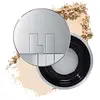Haus Labs By Lady Gaga Bio-Blurring Talc-Free Loose Setting Powder Versus Kosas Cloud Set Brightening Powder
What's inside
What's inside
 Key Ingredients
Key Ingredients

 Benefits
Benefits

 Concerns
Concerns

 Ingredients Side-by-side
Ingredients Side-by-side

Mica
Cosmetic ColorantSqualane
EmollientDiphenyl Dimethicone/Vinyl Diphenyl Dimethicone/Silsesquioxane Crosspolymer
Methyl Methacrylate Crosspolymer
Synthetic Fluorphlogopite
Arnica Montana Flower Extract
MaskingPseudozyma Epicola/Sunflower Seed Oil Ferment Extract Filtrate
Emulsion StabilisingTourmaline
Tocopherol
AntioxidantPentaerythrityl Tetra-Di-T-Butyl Hydroxyhydrocinnamate
AntioxidantCaprylyl Glycol
EmollientEthylhexylglycerin
Skin ConditioningTocopheryl Acetate
AntioxidantGlycerin
HumectantTriethoxycaprylylsilane
C20-24 Olefin
Skin ConditioningAlumina
AbrasiveIron Oxides
CI 77891
Cosmetic ColorantCI 19140
Cosmetic ColorantMica, Squalane, Diphenyl Dimethicone/Vinyl Diphenyl Dimethicone/Silsesquioxane Crosspolymer, Methyl Methacrylate Crosspolymer, Synthetic Fluorphlogopite, Arnica Montana Flower Extract, Pseudozyma Epicola/Sunflower Seed Oil Ferment Extract Filtrate, Tourmaline, Tocopherol, Pentaerythrityl Tetra-Di-T-Butyl Hydroxyhydrocinnamate, Caprylyl Glycol, Ethylhexylglycerin, Tocopheryl Acetate, Glycerin, Triethoxycaprylylsilane, C20-24 Olefin, Alumina, Iron Oxides, CI 77891, CI 19140
Mica
Cosmetic ColorantSilica
AbrasiveCapryloyl Glycerin/Sebacic Acid Copolymer
Skin ConditioningLauroyl Lysine
Skin ConditioningGlyceryl Stearate
EmollientOctyldodecanol
EmollientSimmondsia Chinensis Seed Oil
EmollientPentylene Glycol
Skin ConditioningGlycerin
HumectantGlyceryl Caprylate
EmollientPotassium Sorbate
PreservativeBambusa Arundinacea Stem Powder
AbrasivePassiflora Edulis Seed Oil
EmollientGlyceryl Undecylenate
EmollientWater
Skin ConditioningStearic Acid
CleansingEuphorbia Cerifera Wax
Xanthan Gum
EmulsifyingSodium Phytate
Cetearyl Olivate
Tocopherol
AntioxidantSorbitan Olivate
EmulsifyingHonokiol
AntioxidantPaeonia Officinalis Flower Extract
TonicHelianthus Annuus Seed Oil
EmollientVitis Vinifera Seed Extract
AntimicrobialSodium Benzoate
MaskingCI 77492
Cosmetic ColorantCI 77491
Cosmetic ColorantCI 45410
Cosmetic ColorantCI 19140
Cosmetic ColorantMica, Silica, Capryloyl Glycerin/Sebacic Acid Copolymer, Lauroyl Lysine, Glyceryl Stearate, Octyldodecanol, Simmondsia Chinensis Seed Oil, Pentylene Glycol, Glycerin, Glyceryl Caprylate, Potassium Sorbate, Bambusa Arundinacea Stem Powder, Passiflora Edulis Seed Oil, Glyceryl Undecylenate, Water, Stearic Acid, Euphorbia Cerifera Wax, Xanthan Gum, Sodium Phytate, Cetearyl Olivate, Tocopherol, Sorbitan Olivate, Honokiol, Paeonia Officinalis Flower Extract, Helianthus Annuus Seed Oil, Vitis Vinifera Seed Extract, Sodium Benzoate, CI 77492, CI 77491, CI 45410, CI 19140
Ingredients Explained
These ingredients are found in both products.
Ingredients higher up in an ingredient list are typically present in a larger amount.
CI 19140 is also known as Tartrazine. Tartrazine is a synthetic dye used in cosmetics, foods, and medicine to add a yellow color.
Tartrazine is created from petroleum and is water-soluble.
Some people may experience allergies from this dye, especially asthmatics and those with an aspirin intolerance.
Learn more about CI 19140Glycerin is already naturally found in your skin. It helps moisturize and protect your skin.
A study from 2016 found glycerin to be more effective as a humectant than AHAs and hyaluronic acid.
As a humectant, it helps the skin stay hydrated by pulling moisture to your skin. The low molecular weight of glycerin allows it to pull moisture into the deeper layers of your skin.
Hydrated skin improves your skin barrier; Your skin barrier helps protect against irritants and bacteria.
Glycerin has also been found to have antimicrobial and antiviral properties. Due to these properties, glycerin is often used in wound and burn treatments.
In cosmetics, glycerin is usually derived from plants such as soybean or palm. However, it can also be sourced from animals, such as tallow or animal fat.
This ingredient is organic, colorless, odorless, and non-toxic.
Glycerin is the name for this ingredient in American English. British English uses Glycerol/Glycerine.
Learn more about GlycerinMica is a naturally occurring mineral used to add shimmer and color in cosmetics. It can also help improve the texture of a product or give it an opaque, white/silver color.
Serecite is the name for very fine but ragged grains of mica.
This ingredient is often coated with metal oxides like titanium dioxide. Trace amounts of heavy metals may be found in mica, but these metals are not harmful in our personal products.
Mica has been used since prehistoric times throughout the world. Ancient Egyptian, Indian, Greek, Roman, Aztec, and Chinese civilizations have used mica.
Learn more about MicaTocopherol (also known as Vitamin E) is a common antioxidant used to help protect the skin from free-radicals and strengthen the skin barrier. It's also fat soluble - this means our skin is great at absorbing it.
Vitamin E also helps keep your natural skin lipids healthy. Your lipid skin barrier naturally consists of lipids, ceramides, and fatty acids. Vitamin E offers extra protection for your skin’s lipid barrier, keeping your skin healthy and nourished.
Another benefit is a bit of UV protection. Vitamin E helps reduce the damage caused by UVB rays. (It should not replace your sunscreen). Combining it with Vitamin C can decrease sunburned cells and hyperpigmentation after UV exposure.
You might have noticed Vitamin E + C often paired together. This is because it is great at stabilizing Vitamin C. Using the two together helps increase the effectiveness of both ingredients.
There are often claims that Vitamin E can reduce/prevent scarring, but these claims haven't been confirmed by scientific research.
Learn more about Tocopherol